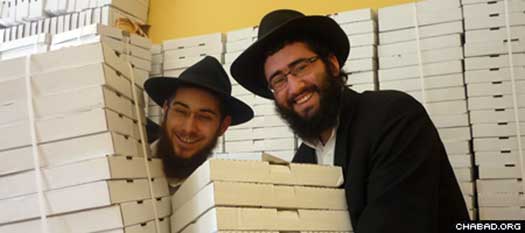
Working to Get the Message Out, One Matzah at a Time
As Passover draws near, Chabad-Lubavitch emissaries the world over distribute millions of handmade shmurah matzahs. And with such a tall order comes the distribution of stories as well.
For example, in 2004, Shmuel Glick was in a New York hospital, battling an aggressive form of cancer. Just before Passover, Glick asked his son Yehuda to go home and get some handmade shmurah matzah and give it to a Jewish E.R. doctor they’d come to know. After the holiday, the doctor visited the Glick family and told them how he treasured the gift, and that his entire family had enjoyed it. Shmuel Glick passed away three months later, but his passion for sharing matzah remains.
Rabbi Yehuda Glick, who now lives in Baltimore, will soon load his car with shmurah matzah and drive an hour to suburban Germantown, Md., where he plans on passing out the hand-rolled, cracker-like wafers to just about every Jewish person he can find. Glick, who together with his wife is opening a new Chabad center in Germantown, sees the shmurah matzah as central to his mission.
“For some people,” he explains, “this will be a reminder that Passover is coming. For others, it will serve to enhance their family Passover celebration, as they see, touch, and then taste matzah rolled by hand and baked in a stone oven just like our ancestors have been doing for generations.
“And for everyone, it will be my way of saying I am here for them.”
Shmurah means “guarded”; the matzah with that name is made from flour that’s been carefully guarded from moisture from the moment the grain was harvested. Most shmurah matzah is baked the old-fashioned way in a handful of places in the United States, Israel, Europe, and more recently, Ukraine. It represents the desire of a people to fulfill G‑d’s will without the intrusion, complication and impersonality of a machine.
Drive initiated in 1954
Just days before Passover 1954, the Lubavitcher Rebbe—Rabbi Menachem M. Schneerson, of righteous memory—lamented the fact that shmurah matzah had become virtually nonexistent, and exhorted Jewish leaders, “rabbis, shochtim (ritual slaughterers), reverends, synagogue caretakers,” and indeed every individual, to do their utmost to distribute hand-baked shmurah matzahs in their communities. The Rebbe said that it had once been customary for rabbis to hand out shmurah matzah to their congregants, and he wished to reinstate the practice. At the very least, he encouraged them to give every individual six matzahs—three for each Seder night—or even two, so that they would have one per night.
Rabbi Berel Mochkin, head of the Chabad Lubavitch Youth Organization of Montreal, remembers that he and a number of other youthful activists began giving out matzahs the very next year. “At that time, most people did not know what it was. We even convinced the local supermarket chain to sell the matzahs. Now they do not need to be convinced, as everyone knows what it is, and people buy it on their own.”
Fifty years later, Mochkin is still giving out matzahs all over the city. Yanky Greene, a student at the Rabbinical College of Canada, says he and a friend brought some to Jewish businesspeople in Old Montreal. “Sure, they were happy to get them. Some of them looked and said, ‘Oh, shmurah matzah!’ But others didn’t know what it was, so we filled them in.”
Dr. Gerald Avertick, an optometrist who’s been receiving the matzah for many years from various Chabad organizations in Montreal, says they have changed his family’s Passover experience. “It used to be that we would get machine matzahs, and use the extra matzahs from Chabad just at the Seder. But now the kids like the hand matzah better than the other stuff. I go out and buy it every year, so that we will have enough.”
Rabbi Yisroel Shmotkin, executive director of Chabad-Lubavitch of Wisconsin, who distributes 1,000 pounds of shmurah matzah yearly, says that things have indeed changed since he began giving out matzahs in 1969. “The success of the Rebbe’s campaign can perhaps be seen in how the bakeries have begun to cater to individual distribution. When I first started, I would order large boxes, only to discover that a third of the matzahs would invariably be broken by the time they got off the truck, and we had to repackage them into boxes of six. There was no way that we were going to give out broken matzah. After all, for most people, this is their matzah for the Seder.”
Today, the bakeries have recognized the importance of packing for distance, and even sell smaller boxes. He adds: “We still carefully check every box to make sure that the matzahs are whole.”
Shmotkin still proffers a portion of his matzah packages personally, but sheer volume and distance dictate that he share the burden with delivery services and UPS. In fact, many people come to pick up their own—an indication of how deeply rooted shmurah matzah has once again become in the Jewish experience. He recalls receiving letters from people telling him how they had not been planning on having a Seder, but when the shmurah matzah arrived, they quickly arranged one. Others wrote that these matzahs had given them the encouragement to celebrate Passover properly, eating no leavened foods for the duration of the eight-day holiday.
In his words, “Sharing these authentic matzahs lifted them up to get in touch with their inner selves.”
In Cherry Hill, N.J., where Rabbi Mendy Kaminker runs the Israeli Chabad Center, he says that he sees shmurah matzah distribution as a special opportunity. “In addition to the spiritual benefits these matzahs bring, going out each evening and delivering them to people’s homes gives me the chance to offer them a special gift. It has become a tradition. They invite me in, we talk, and I hand them the matzahs.”
Kaminker says he begins his visits well before the holiday, because “the better we get to know each other, the longer I end up staying in each house, and the fewer homes I get to reach each night.”

















Shua
Go Shua!
So proud....
Keep the smile & work Mendel Wineberg…